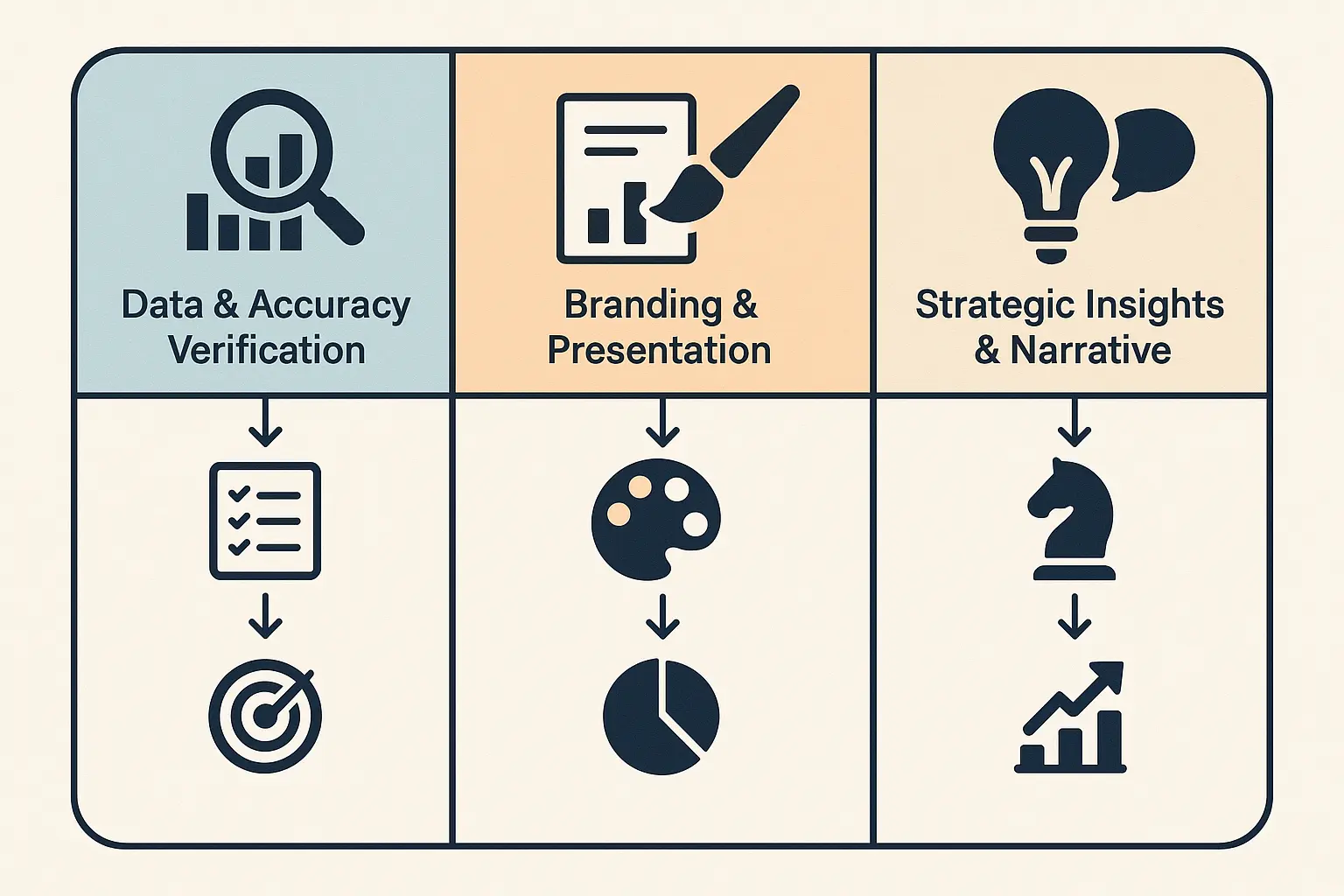The Agency Pre-Flight Check: A QA Checklist for Reviewing Partner SEO Reports Before Client Delivery
You’ve been there. A new SEO report from your white-label partner lands in your inbox—a PDF packed with data, charts, and bullet points. Your client is expecting it by the end of the day.
For a moment, you hover your mouse over the “Forward” button. It’s tempting to just attach it, write a quick “Here’s this month’s report!” email, and move on to the ten other things on your to-do list.
But you pause. Because that PDF isn’t just a report; it’s your reputation. It’s the primary tool you use to prove value, maintain trust, and justify your client’s investment. And with a staggering 57% of marketing professionals citing “proving ROI” as a top challenge, that proof is more critical than ever. Sending a partner’s report without a thorough review is like a pilot taking off without checking the flight plan.
That’s why this pre-flight check is non-negotiable. This isn’t about mistrusting your partner; it’s about ownership. It’s the crucial step that turns a third-party deliverable into your agency’s strategic counsel.
Why a Pre-Flight Check Is Your Secret Weapon
In today’s agency landscape, specialization and partnership are key to growth. As 63% of businesses outsource their marketing in some capacity, leveraging white-label SEO services is a smart, scalable way to expand your offerings without the overhead.
But the client hired you. They trust your brand, your expertise, and your voice. A pre-flight QA process makes sure every communication, especially a performance report, reinforces that trust. It’s your opportunity to catch small errors before they become big problems, translate raw data into a compelling narrative, and add the strategic layer that only you can provide.
The Ultimate QA Checklist for White-Label SEO Reports
Think of this checklist as your co-pilot. Run through these four critical areas before any report goes to a client.
Part 1: Branding & Presentation: Is It Your Report?
This is the first and easiest check, but it’s amazing how often it gets overlooked. The client should feel like this report was crafted by your in-house team, creating a seamless experience.
-
Logo & Colors: Is your agency’s logo prominent? Are all partner logos or branding completely removed? Do the colors of the charts and headings align with your brand palette?
-
Tone & Language: Read through the summaries and callouts. Does the language match your agency’s communication style? If you’re known for a casual, friendly tone, a report filled with dense, academic jargon will feel jarring.
-
Client-Centric Formatting: Is the report clean, easy to read, and professional? Avoid walls of text or overly complicated charts. The most important information should be front and center.

Part 2: Data Accuracy & Clarity: Are the Numbers Right?
A single incorrect data point can undermine the credibility of the entire report. While a good partner double-checks their work, you are the last line of defense.
-
Verify the Reporting Period: Does the report cover the correct date range (e.g., October 1–October 31)?
-
Spot-Check Key Metrics: You don’t need to rebuild the report from scratch. Just cross-reference one or two key metrics. For example, pull up Google Analytics 4 and compare the Organic Traffic number with what’s in the report. Do they match?
-
Check for Broken Visuals: Make sure all graphs and charts are rendering correctly. Are the axes labeled clearly? Is anything cut off or unreadable?
-
Define the Jargon: Does the report use terms like “SERP,” “Domain Authority,” or “Crawl Budget” without explanation? Add a simple definition or footnote to keep it accessible for a non-SEO audience.
Part 3: Strategic Narrative & Insights: Does It Tell a Story?
This is where you add your most significant value. Data without a story is just noise. Your job is to connect the dots and explain the “so what” behind the numbers. Since generating traffic and leads is the top challenge for 61% of marketers, your report must show how your SEO efforts are solving that problem.
-
Connect Activities to Outcomes: The report shouldn’t just list activities and results separately—it must connect them. For example: “Because we optimized five key service pages last month (the activity), we saw a 20% increase in organic traffic to those pages and generated three new leads through their contact forms (the outcome).”
-
Highlight the Wins: Is there a particularly impressive keyword ranking improvement? A blog post that took off? Call it out. Don’t make the client hunt for the good news.
-
Address the “Why”: If a metric is down, provide context. Was it a seasonal dip? A Google algorithm update? Proactively explaining potential setbacks builds trust far more than ignoring them.
-
Frame Around Client Goals: Tie every SEO metric back to the business objectives that matter to your client. Instead of saying, “We increased organic traffic by 15%,” try, “We increased organic traffic by 15%, bringing 300 more potential customers to the website this month.”

Part 4: Next Steps & Action Plan: What Happens Now?
A great report is both a rearview mirror and a GPS, showing clearly where you’ve been and where you’re going.
-
Clear Priorities: Does the report explicitly state the top two or three priorities for the upcoming month?
-
Actionable Recommendations: Are the next steps clear and concise? The client should understand exactly what your team (and your partner) will be working on.
-
Assign Ownership: Clarify what, if anything, you need from the client (e.g., “Please provide feedback on the attached blog briefs by Friday”).
Turning a Good Report into a Great Client Experience
Once your checklist is complete, consider one final touch: a personalized executive summary.
Try recording a short (2–3 minute) video using a tool like Loom. You can share your screen, walk the client through the report’s key highlights, and add your personal strategic perspective. This small effort elevates a static document into a dynamic conversation, reinforcing your role as their trusted guide.

Frequently Asked Questions (FAQ)
Q: How much time should I budget for this review?
A: When you first start with a new partner, budget 30–45 minutes. As you build a rhythm and trust, you’ll find you can do it in as little as 15–20 minutes. The time invested pays dividends in client confidence.
Q: What if I find a mistake in the data?
A: Contact your SEO partner immediately. A professional partner will be responsive and eager to correct any issues. How they handle this is a great test of the partnership. The goal isn’t to play “gotcha,” but to collaborate on a flawless client deliverable.
Q: My agency doesn’t specialize in SEO. How can I add valuable insights?
A: This is where you have a superpower. You can connect SEO results to the other marketing channels you manage. For example: “The surge in organic traffic to the new landing page perfectly supported the paid ad campaign we launched last week.” You provide the holistic business view that a siloed provider can’t.
Q: What’s the difference between a data dump and a strategic report?
A: A data dump shows what happened (e.g., “Traffic was 10,000 visits”). A strategic report explains why it happened, what it means for the business, and what we should do next.
The Final Check: Building a Seamless Partnership
Mastering the art of SEO outsourcing isn’t just about finding a good provider; it’s about building a seamless workflow that protects your brand and delights your clients. This pre-flight checklist is a cornerstone of that process.
By taking ownership of the final deliverable, you ensure every report reinforces your value, tells a compelling story of progress, and strengthens your client relationships. Over time, you’ll find that the right partner delivers reports that are 95% client-ready, making your job easier and your agency more profitable. This process is how you move from being a reseller to a true strategic leader.

